Roland TD-4 User Manual
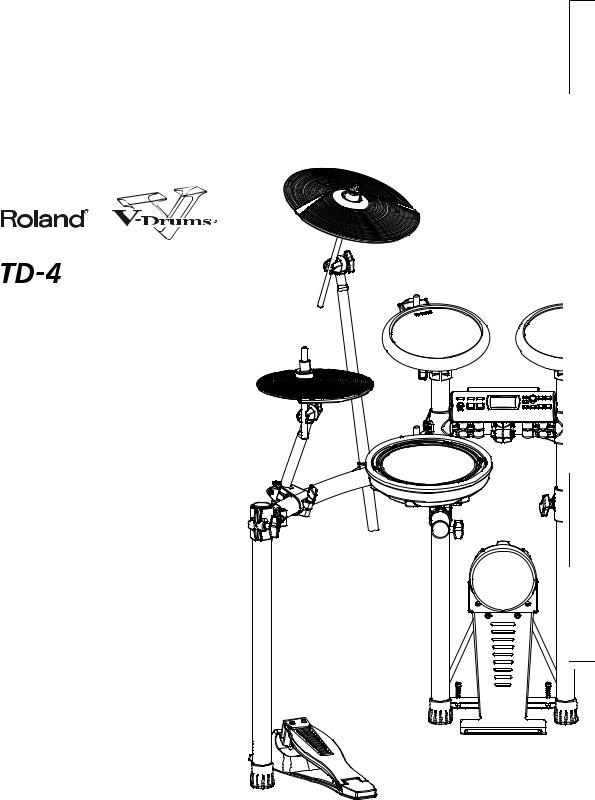
Owner’s Manual Bedienungsanleitung Mode d’emploi Manuale dell’utente Manual del usuario Manual do proprietário Gebruikershandleiding
English |
Deutsch |
Français |
Italiano |
Español |
Português |
Nederlands |
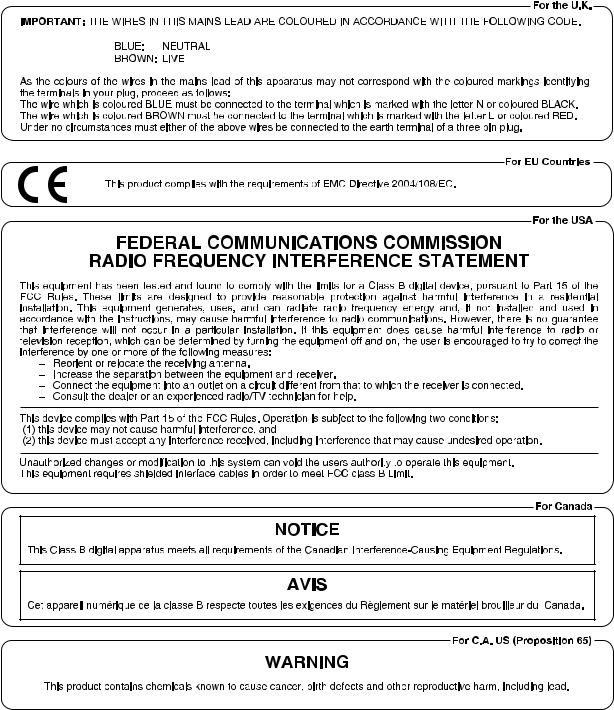
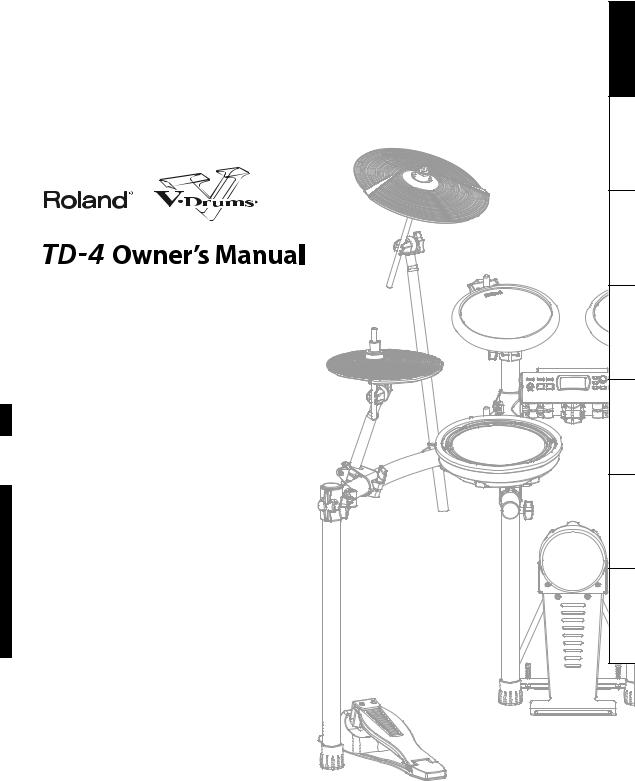
Thank you, and congratulations on your choice of the Roland Percussion Sound Module TD-4.
Before using this unit, carefully read the sections entitled: “USING THE UNIT SAFELY” and “IMPORTANT NOTES” (Owner’s manual p. 2–3; p. 4). These sections provide important information concerning the proper operation of the unit. Additionally, in order to feel assured that you have gained a good grasp of every feature provided by your new unit, Owner’s manual should be read in its entirety.
The manual should be saved and kept on hand as a convenient reference.
Copyright ©2009 ROLAND CORPORATION
All rights reserved. No part of this publication may be
reproduced in any form without the written permission of
ROLAND CORPORATION.
English |
Deutsch |
Français |
Italiano |
Español |
Português |
Nederlands |
1
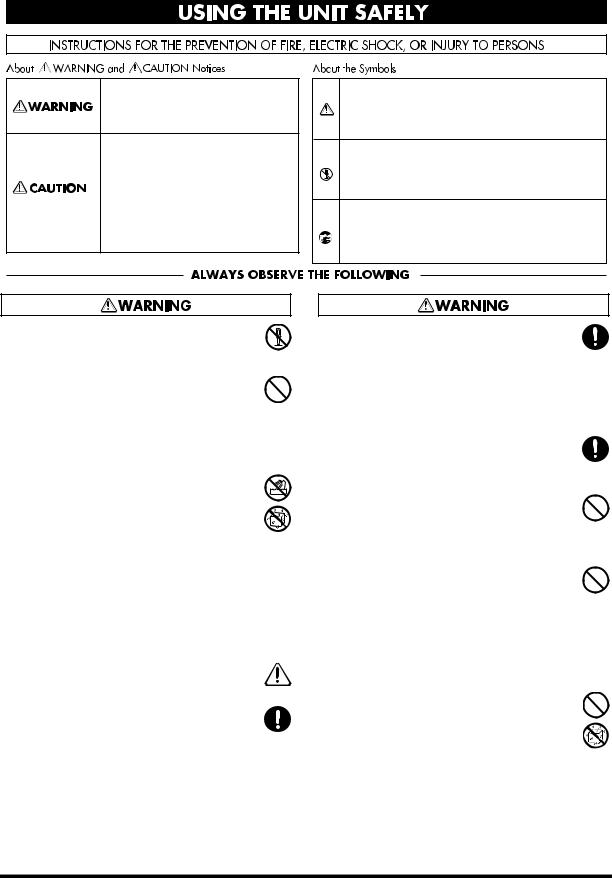
Used for instructions intended to alert the user to the risk of death or severe injury should the unit be used improperly.
Used for instructions intended to alert the user to the risk of injury or material damage should the unit be used improperly.
* Material damage refers to damage or other adverse effects caused with respect to the home and all its furnishings, as well to domestic animals or pets.
•Do not open (or modify in any way) the unit or its AC adaptor.
....................................................................................................................
•Do not attempt to repair the unit, or replace parts within it (except when this manual provides specific instructions directing you to do so). Refer all servicing to your retailer, the nearest Roland Service Center, or an authorized Roland distributor, as listed on the “Information” page.
....................................................................................................................
• Never install the unit in any of the following locations.
• Subject to temperature extremes (e.g., direct sunlight in an enclosed vehicle, near a heating duct, on top of heat-generating equipment); or are
•Damp (e.g., baths, washrooms, on wet floors); or are
•Exposed to steam or smoke; or are
•Subject to salt exposure; or are
•Humid; or are
•Exposed to rain; or are
•Dusty or sandy; or are
•Subject to high levels of vibration and shakiness.
....................................................................................................................
•This unit should be used only with a stand that is
recommended by Roland.
....................................................................................................................
•When using the unit with a stand recommended by
Roland, the stand must be carefully placed so it is level and sure to remain stable. If not using a stand, you still need to make sure that any location you choose for placing the unit provides a level surface that will
properly support the unit, and keep it from wobbling.
....................................................................................................................
The  symbol alerts the user to important instructions or warnings.The specific meaning of the symbol is determined by the design contained within the triangle. In the case of the symbol at left, it is used for general cautions, warnings, or alerts to danger.
symbol alerts the user to important instructions or warnings.The specific meaning of the symbol is determined by the design contained within the triangle. In the case of the symbol at left, it is used for general cautions, warnings, or alerts to danger.
The  symbol alerts the user to items that must never be carried out (are forbidden). The specific thing that must not be done is indicated by the design contained within the circle. In the case of the symbol at left, it means that the unit must never be disassembled.
symbol alerts the user to items that must never be carried out (are forbidden). The specific thing that must not be done is indicated by the design contained within the circle. In the case of the symbol at left, it means that the unit must never be disassembled.
The ● symbol alerts the user to things that must be carried out. The specific thing that must be done is indicated by the design contained within the circle. In the case of the symbol at left, it means that the power-cord plug must be unplugged from the outlet.
•Be sure to use only the AC adaptor supplied with the
unit. Also, make sure the line voltage at the installation matches the input voltage specified on the AC
adaptor’s body. Other AC adaptors may use a different polarity, or be designed for a different voltage, so their use could result in damage, malfunction, or electric shock.
....................................................................................................................
•Use only the attached power-supply cord. Also, the
supplied power cord must not be used with any other device.
....................................................................................................................
•Do not excessively twist or bend the power cord, nor place heavy objects on it. Doing so can damage the cord, producing severed elements and short circuits. Damaged cords are fire and shock hazards!
....................................................................................................................
•This unit, either alone or in combination with an amplifier and headphones or speakers, may be capable of producing sound levels that could cause permanent hearing loss. Do not operate for a long period of time at a high volume level, or at a level that is uncomfortable. If you experience any hearing loss or ringing in the ears, you should immediately stop using the unit, and consult an audiologist.
....................................................................................................................
•Do not allow any objects (e.g., flammable material, coins, pins); or liquids of any kind (water, soft drinks, etc.) to penetrate the unit.
....................................................................................................................
2
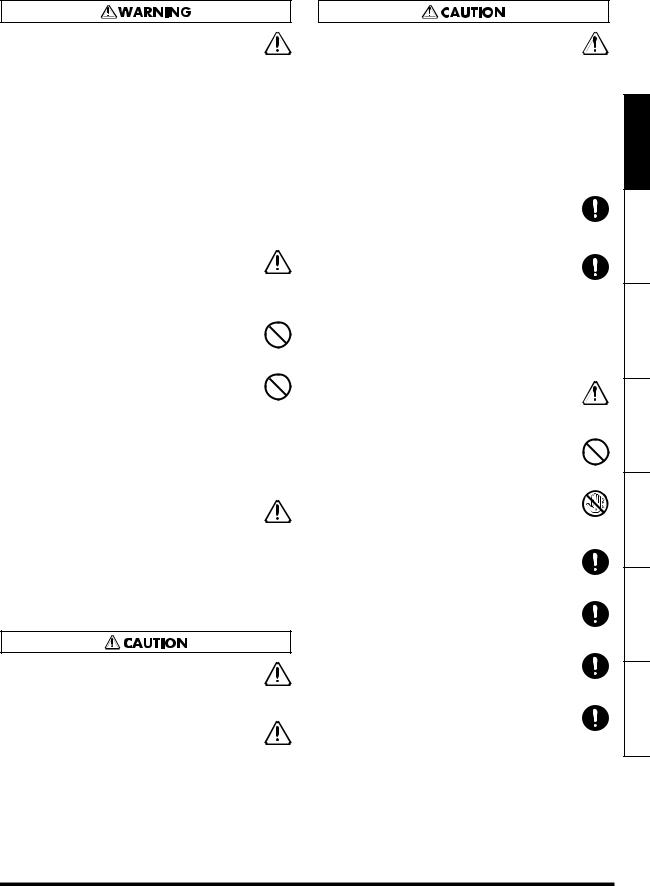
•Immediately turn the power off, remove the AC
adaptor from the outlet, and request servicing by your retailer, the nearest Roland Service Center, or an authorized Roland distributor, as listed on the “Information” page when:
•The AC adaptor, the power-supply cord, or the plug has been damaged; or
•If smoke or unusual odor occurs
•Objects have fallen into, or liquid has been spilled onto the unit; or
•The unit has been exposed to rain (or otherwise has become wet); or
•The unit does not appear to operate normally or exhibits a marked change in performance.
....................................................................................................................
•In households with small children, an adult should
provide supervision until the child is capable of following all the rules essential for the safe operation
of the unit.
....................................................................................................................
•Protect the unit from strong impact. (Do not drop it!)
....................................................................................................................
•Do not force the unit’s power-supply cord to share an outlet with an unreasonable number of other devices. Be especially careful when using extension cords—the total power used by all devices you have connected to the extension cord’s outlet must never exceed the power rating (watts/amperes) for the extension cord. Excessive loads can cause the insulation on the cord to heat up and eventually melt through.
....................................................................................................................
•Before using the unit in a foreign country, consult with
your retailer, the nearest Roland Service Center, or an authorized Roland distributor, as listed on the “Information” page.
....................................................................................................................
•The unit and the AC adaptor should be located so
their location or position does not interfere with their proper ventilation.
....................................................................................................................
•This (TD-4) for use only with Roland stand MDS series.
Use with other stands is capable of resulting in instability causing possible injury.
....................................................................................................................
•Please be sure to read and adhere to the cautionary
notices contained in the instructions that came with this product.
Please note that, depending on the manner in which keyboard performances are carried out, you may encounter situations where the keyboard falls off the stand or the stand topples over, even though you have followed all of the instructions and advice contained within the product’s manual. For this reason, you should always perform a safety check each time you use the stand.
....................................................................................................................
•Always grasp only the plug on the AC adaptor cord
when plugging into, or unplugging from, an outlet or this unit.
....................................................................................................................
•At regular intervals, you should unplug the AC adaptor
and clean it by using a dry cloth to wipe all dust and other accumulations away from its prongs. Also, disconnect the power plug from the power outlet whenever the unit is to remain unused for an
extended period of time. Any accumulation of dust between the power plug and the power outlet can result in poor insulation and lead to fire.
....................................................................................................................
•Try to prevent cords and cables from becoming
entangled. Also, all cords and cables should be placed so they are out of the reach of children.
....................................................................................................................
•Never climb on top of, nor place heavy objects on the unit.
....................................................................................................................
• Never handle the AC adaptor or its plugs with wet hands when plugging into, or unplugging from, an outlet or this unit.
....................................................................................................................
•Before moving the unit, disconnect the AC adaptor
and all cords coming from external devices.
....................................................................................................................
•Before cleaning the unit, turn off the power and
unplug the AC adaptor from the outlet.
....................................................................................................................
•Whenever you suspect the possibility of lightning in
your area, disconnect the AC adaptor from the outlet.
....................................................................................................................
•Keep any caps and wing bolts you may remove in a
safe place out of children’s reach, so there is no chance of them being swallowed accidentally.
....................................................................................................................
English
Deutsch
Français
Italiano
Nederlands Português Español
3


 IMPORTANT NOTES
IMPORTANT NOTES
Power Supply
•Do not connect this unit to same electrical outlet that is being used by an electrical appliance that is controlled by an inverter (such as a refrigerator, washing machine, microwave oven, or air conditioner), or that contains a motor. Depending on the way in which the electrical appliance is used, power supply noise may cause this unit to malfunction or may produce audible noise. If it is not practical to use a separate electrical outlet, connect a power supply noise filter between this unit and the electrical outlet.
•The AC adaptor will begin to generate heat after long hours of consecutive use. This is normal, and is not a cause for concern.
•Before connecting this unit to other devices, turn off the power to all units. This will help prevent malfunctions and/or damage to speakers or other devices.
Placement
•Using the unit near power amplifiers (or other equipment containing large power transformers) may induce hum. To alleviate the problem, change the orientation of this unit; or move it farther away from the source of interference.
•This device may interfere with radio and television reception. Do not use this device in the vicinity of such receivers.
•Noise may be produced if wireless communications devices, such as cell phones, are operated in the vicinity of this unit. Such noise could occur when receiving or initiating a call, or while conversing. Should you experience such problems, you should relocate such wireless devices so they are at a greater distance from this unit, or switch them off.
•Do not expose the unit to direct sunlight, place it near devices that radiate heat, leave it inside an enclosed vehicle, or otherwise subject it to temperature extremes. Excessive heat can deform or discolor the unit.
•When moved from one location to another where the temperature and/or humidity is very different, water droplets (condensation) may form inside the unit. Damage or malfunction may result if you attempt to use the unit in this condition. Therefore, before using the unit, you must allow it to stand for several hours, until the condensation has completely evaporated.
Maintenance
•For everyday cleaning wipe the unit with a soft, dry cloth or one that has been slightly dampened with water. To remove stubborn dirt, use a cloth impregnated with a mild, nonabrasive detergent. Afterwards, be sure to wipe the unit thoroughly with a soft, dry cloth.
•Never use benzine, thinners, alcohol or solvents of any kind, to avoid the possibility of discoloration and/or deformation.
Repairs and Data
•Please be aware that all data contained in the unit’s memory may be lost when the unit is sent for repairs. Important data should always be written down on paper (when possible).
During repairs, due care is taken to avoid the loss of data. However, in certain cases (such as when circuitry related to memory itself is out of order), we regret that it may not be possible to restore the data, and Roland assumes no liability concerning such loss of data.
Additional Precautions
•Use a reasonable amount of care when using the unit’s buttons, sliders, or other controls; and when using its jacks and connectors. Rough handling can lead to malfunctions.
•Never strike or apply strong pressure to the display.
•When connecting / disconnecting all cables, grasp the connector itself—never pull on the cable. This way you will avoid causing shorts, or damage to the cable’s internal elements.
•To avoid disturbing your neighbors, try to keep the unit’s volume at reasonable levels. You may prefer to use headphones, so you do not need to be concerned about those around you (especially when it is late at night).
•Since sound vibrations can be transmitted through floors and walls to a greater degree than expected, take care not to allow such sound to become a nuisance to neighbors, especially at night and when using headphones. Although the drum pads and pedals are designed so there is a minimal amount of extraneous sound produced when they’re struck, rubber heads tend to produce louder sounds compared to mesh heads. You can effectively reduce much of the unwanted sound from the pads by switching to mesh heads.
•When you need to transport the unit, package it in the box (including padding) that it came in, if possible. Otherwise, you will need to use equivalent packaging materials.
•Some connection cables contain resistors. Do not use cables that incorporate resistors for connecting to this unit. The use of such cables can cause the sound level to be extremely low, or impossible to hear. For information on cable specifications, contact the manufacturer of the cable.
•The explanations in this manual include illustrations that depict what should typically be shown by the display. Note, however, that your unit may incorporate a newer, enhanced version of the system (e.g., includes newer sounds), so what you actually see in the display may not always match what appears in the manual.
•If there is a danger that you might accidentally strike the unit during performance, adjust the locations at which Tom 1 (T1) and Tom 2 (T2) are attached to the stand, to reduce the gap between the pads.
4

 Contents
Contents
USING THE UNIT SAFELY.......................... |
2 |
IMPORTANT NOTES .................................. |
4 |
Panel Descriptions ................................... |
6 |
Front Panel ........................................................................... |
6 |
Side Panel ............................................................................. |
7 |
Rear Panel ............................................................................. |
7 |
Bottom Panel...................................................................... |
7 |
Getting Ready to Play .............................. |
8 |
Mounting the TD-4 on the Stand ................................. |
8 |
Connecting Your Audio Equipment............................ |
9 |
Turning the Power On/Off ........................................... |
10 |
Saving Your Settings ........................................................................ |
10 |
Tensioning the Head of a Mesh Pad (PDX-8) ........ |
11 |
Playing..................................................... |
12 |
Hearing What the Kits Sound Like ............................ |
12 |
Selecting a Drum Kit ...................................................... |
12 |
About the “DRUM KIT” screen....................................................... |
12 |
Performance Techniques ............................................. |
13 |
Pads (e.g., PDX-8, PD-8)................................................................... |
13 |
Cymbals (e.g., CY-8, CY-12R/C) ..................................................... |
13 |
Hi-Hat (CY-5)........................................................................................ |
14 |
Hi-Hat Control Pedal FD-8.............................................................. |
14 |
Quickly Tuning or Muffling.......................................... |
15 |
TUNING.................................................................................................. |
15 |
MUFFLING ............................................................................................ |
15 |
Playing Along with a Portable Audio Player ......... |
16 |
Practicing ................................................ |
17 |
Playing with the Metronome...................................... |
17 |
Quick Recording and Playback (QUICK REC)......... |
17 |
Recording ............................................................................................. |
17 |
Playback................................................................................................ |
18 |
Using Time Check to Check Your Recorded Performance . 18 |
|
Practicing in Coach Mode ............................................ |
19 |
Selecting a Practice Menu .............................................................. |
19 |
<1> WARM UPS.................................................................................. |
20 |
<2> |
|
Correctly Playing in Time with the Beat (TIME CHECK)........ |
22 |
<3> |
|
Continuing to play at a steady tempo (TEMPO CHECK)...... |
23 |
<4> |
|
Developing Internal Timing Sense (QUIET COUNT).............. |
24 |
<5> |
|
Gradually raising and lowering the tempo (AUTO UP/DOWN)..... |
26 |
Creating a Drum Kit ................................ |
27 |
Selecting the Parameters ............................................. |
27 |
Editing Instrument Parameters (INSTRUMENT) ... |
28 |
Adjusting the volume of the pads or drum kit |
|
(MIXER)................................................................................ |
29 |
Using the Onboard Effects (AMBIENCE) ................. |
30 |
Naming a Drum Kit (KIT NAME).................................. |
30 |
Copying a Drum Kit (COPY)......................................... |
31 |
Exchanging Drum Kits (EXCHANGE) ........................ |
32 |
Restoring a Drum Kit (RESTORE)................................ |
33 |
System Settings....................................... |
34 |
Specifying How the Metronome will Sound |
|
(METRONOME) ................................................................. |
34 |
Editing the pad settings (PAD SETTINGS) .............. |
35 |
Specifying the Type of Pad ............................................................ |
35 |
Setting the Pad Sensitivity ............................................................. |
35 |
Specifying How the CR2 Trigger Cable will be Used ............ |
36 |
Other Settings (OPTIONS) ............................................ |
36 |
Adjusting the Display Contrast (LCD Contrast) ...................... |
37 |
Adjusting the Brightness of the Backlight (LCD Bright) ...... |
37 |
Adjusting the Button Operating Sound (Keypad Sound)... |
37 |
Allowing the Head and Rim Settings to be Edited |
|
Separately (Head/Rim Link) ........................................................... |
37 |
Restoring the Factory Settings (Factory Reset)....................... |
37 |
Expanding your drum set....................... |
38 |
Adding a CRASH 2 cymbal........................................... |
38 |
Using a CY-12R/C or CY-15R instead of the |
|
CY-8 cymbal ...................................................................... |
38 |
Using the VH-11 V Hi-hat.............................................. |
39 |
Connecting the VH-11 and Making Settings on the TD-4..... |
39 |
Other Settings ......................................... |
41 |
MIDI Settings .................................................................... |
41 |
MIDI-related Settings ....................................................................... |
41 |
Detailed Settings for Trigger Parameters............... |
42 |
Protecting Modified Kits and Settings |
|
(Edit Lock) .......................................................................... |
45 |
Troubleshooting ..................................... |
46 |
Error Messages ........................................ |
48 |
Drum Kit/Instrument List ....................... |
49 |
MIDI Implementation Chart ................... |
51 |
Specifications .......................................... |
52 |
Index ........................................................ |
53 |
English
Deutsch
Français
Italiano
Nederlands Português Español
5

 Panel Descriptions
Panel Descriptions
Front Panel
7 9 11 12
|
1 |
|
|
|
|
|
|
|
|
2 |
|
|
|
|
|
|
|
|
3 |
5 |
4 |
6 |
8 |
10 |
13 |
14 |
1. |
[POWER] button |
|
|
9. |
[-/+] dial |
|
|
|
Turns the power on/off (p. 10).
2.[VOLUME] knob
Adjusts the volume from the OUTPUT and PHONES jacks (p. 10).
Use this dial to edit a value.
Use this to adjust a value. Turning the dial toward “+” will increase the value, and turning it toward “-” will decrease the value.
3.[TUNING] button
Use this when you want to tune each instrumental sound (p. 15).
10.[OK] button
Use this to confirm a menu item to use with the Coach function, or to confirm a value you’ve edited.
4.[MUFFLING] button
Use this when you want to muffle (mute) each instrumental sound (p. 15).
5.DRUM KIT [<] [>] buttons
Use these to switch drum kits (p. 12). You’ll also use these buttons to return to the drum kit screen from other screens (except during recording/playback).
6.Display
During performance, this shows the drum kit name and other information. During editing, this shows the contents of the settings.
The backlight will automatically dim when no panel operations have been performed for a certain period of time.
7.[MENU] button
Use this when you want to make various settings for the TD- 4, such as editing the settings of a drum kit or adjusting the pads.
11.[COACH] button
Press this when you want to use the Coach function (p. 19).
12.[  ] (Metronome) button
] (Metronome) button
This turns the metronome on (sounding) or off (silent) (p. 17).
13.QUICK REC [  ] (Rec) button
] (Rec) button
Use this to record your playing (p. 17).
14.QUICK REC [ 
 ] (Play/Stop) button
] (Play/Stop) button
Play back what you recorded (p. 18).
With some buttons, a sound is produced when you press them.
If you want, you can turn off this sound (p. 37).
8.SEL [  ] [
] [  ] button
] button
Use this to select a menu item when using the Coach function, or to select parameters when making various settings for the TD-4.
6

Panel Descriptions
Side Panel
15
15.MIDI OUT connector
Use this when you want to use the pads to play external MIDI sound sources or for recording with sequencers (p. 41).
Rear Panel
18 19 20
18.DC IN jack
Connect the included AC adaptor here (p. 9).
19.TRIGGER INPUT connector
Connecting the special cable connects the pads and pedals to the TD-4 (p. 8).
20.OUTPUT jacks (L/MONO, R)
All sounds of the TD-4 are output here. Use for connecting to an amp or other external audio equipment.
If you’re working in mono, only use the L/MONO jack.
16 17
16.MIX IN jack
For connecting an external audio source such as MP3 or CD players (p. 16). All sound input here is also sent from the OUTPUT and PHONES jacks.
*To adjust the volume, use the controls of the external device connected to MIX IN.
17.PHONES jack
For connecting stereo headphones (p. 9).
Using the headphone jack will not mute the main OUTPUT jacks.
Bottom Panel
21 22
21.Sound module mounting plate attachment holes
Attach the included sound module mounting plate here so that you can attach the TD-4 to your drum stand.
22.Security Slot (  ) http://www.kensington.com/
) http://www.kensington.com/
English
Deutsch
Français
Italiano
Nederlands Português Español
7
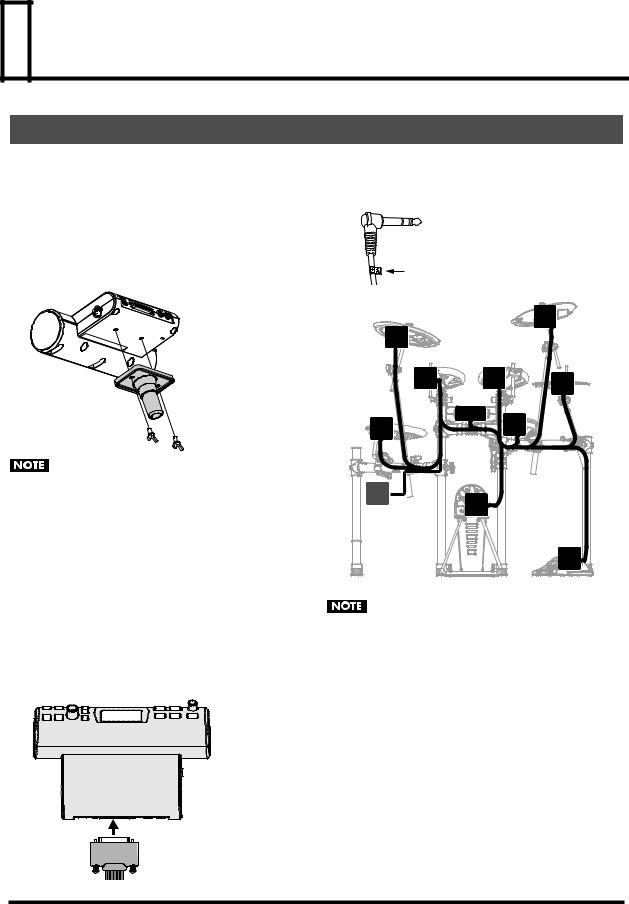
 Getting Ready to Play
Getting Ready to Play
Mounting the TD-4 on the Stand
1.Attach the included sound module mounting plate to the TD-4.
Use the included wing bolts to attach the plate as shown in the illustration.
*Use only the included wing bolts. Using any other nuts may cause malfunction.
*You must use the TD-4 with the sound module mounting plate installed.
Labels indicating the pad to be connected are attached to the cable.
Connect the pads and pedals as shown in the illustration.
•When turning the unit upside-down, get a bunch of newspapers or magazines, and place them under the four corners or at both ends to prevent damage to the buttons and controls. Also, you should try to orient the unit so no buttons or controls get damaged.
•When turning the unit upside-down, handle with care to avoid dropping it, or allowing it to fall or tip over.
2.Attach the TD-4 (with the sound module mounting plate installed) to your drum stand (such as the MDS-4; available separately).
3.Connect the included cable to the TD-4’s TRIGGER INPUT connector, and connect your pads and pedals.
CR1
RD
T2 T1 HH
|
TD-4 |
T3 |
SNR |
CR2 |
KIK
HHC
•If you don’t connect a pad to each of the cables, make the following settings for unconnected pads in order to prevent malfunction.
• Turn the Pad Type setting OFF (p. 35).
•If you’re not using the CR2, leave the CR2 cable cap attached, and fasten the cable to the stand so that it does not interfere with your playing.
•The included connection cables are the optimal length for when they're attached to the MDS-4. If you’re using a different stand, you'll need to provide extension cables.
8
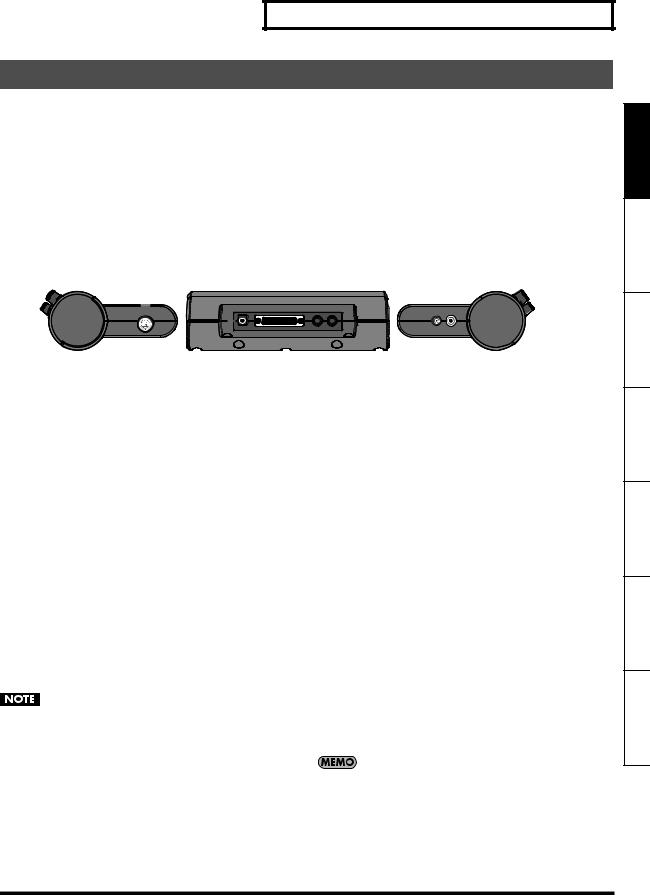
Getting Ready to Play
Connecting Your Audio Equipment
Portable Audio Player
MIDI Sound Module
MIDI IN
Stereo miniature plug
Stereo 1/4” phone plug
AC Adaptor
Power Cord |
Indicator |
|
|
Stereo
Headphones
To AC Outlet
Powered Amp, etc |
|
|
|
Audio Set, etc |
|||
1.Power-off all equipment before making connections.
To prevent malfunction and/or damage to speakers or other devices, always turn down the volume, and turn off the power on all devices before making connections.
3.Connect the included AC adaptor to the DC IN jack.
Place the AC adaptor so the side with the indicator (see illustration) faces upwards and the side with written information faces downwards.
* The indicator will light when you plug the AC adaptor into an AC outlet.
2. Connect the OUTPUT jacks (L/MONO, R) to your
audio system or amp. |
Using the MIX IN jack allows playing along with music from a |
|
portable audio player or other external sources (p. 16). |
||
|
*If you’re using headphones, connect them to the PHONES jack.
English
Deutsch
Français
Italiano
Nederlands Português Español
9
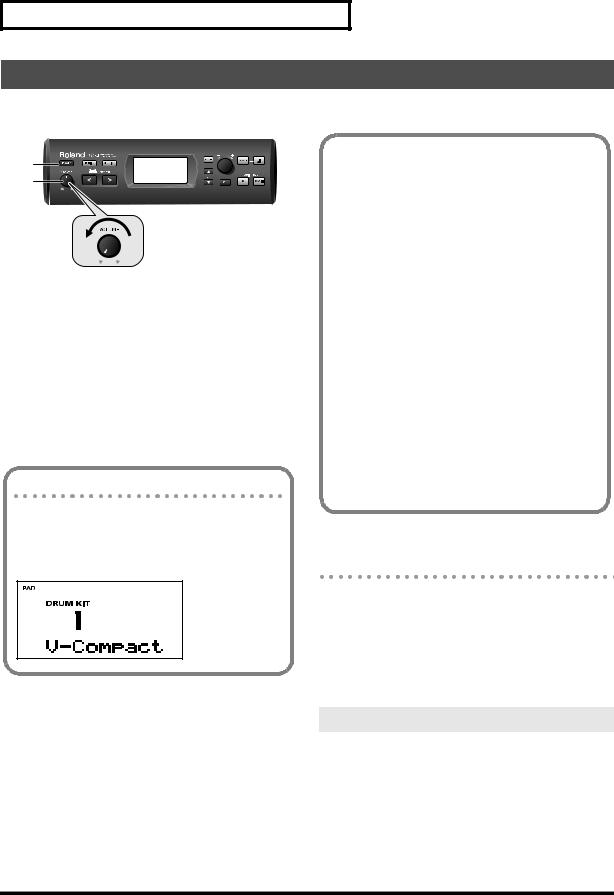
Getting Ready to Play
Turning the Power On/Off
*Once connections have been made (p. 9), turn on the power to the connected equipment in the order specified. Doing it in the wrong order raises the risk of damage/malfunction to that equipment.
3
1
1.Turn the [VOLUME] knob all the way to the left.
2.Minimize the volume of the connected amp or audio system.
3.Press the [POWER] button.
* Even with the volume all the way down, you may still hear some sound when the power is switched on, but this is normal, and does not indicate a malfunction.
*The TD-4 is equipped with a protection circuit and requires a brief interval a few seconds) after powering before it will operate normally.
Caution when Turning On the Power
After you turn on the power, do NOT touch any pads or pedals until the drum kit name (the illustration below) has appeared in the display. Doing so can cause various problems.
ig.d-OpenKitNo1.eps
4.Power-on the connected amp or audio system.
5.While hitting a pad, gradually turn the [VOLUME] knob toward the right to adjust the volume.
Adjust the volume of the connected amp/ audio system to the desired level.
If you don’t hear any sound
Check the following points.
Pad and Pedal Connections
•Is the cable correctly connected to the TRIGGER INPUT connector?
•Are the cables correctly connected to each pad or pedal?
When Using an Amp or Audio System
•Are the TD-4’s OUTPUT jacks connected correctly to the input jacks of your amp/audio system?
•Are the input selections and volume settings correct on that amp/audio system?
•Possible problem with the connection cables themselves?
•Isn’t the [VOLUME] knob turned all the way to the left?
•Have the input select settings of your audio system or amp been made correctly?
•Is the amp or audio system volume setting correct?
When using headphones
•Are your headphones plugged into PHONES jack?
•Isn’t the [VOLUME] knob turned all the way to the left?
Turning the Power Off
1.Turn the volume down on the TD-4 and any connected equipment.
2.Power-off the connected equipment.
3.Hold down the [POWER] button until the display indicates “See you!”
Saving Your Settings
The TD-4 does not have a specific “operation” for saving your settings. Any changes you’ve made will be saved when you turn off the power.
* You must turn off the power by pressing the [POWER] button.
10
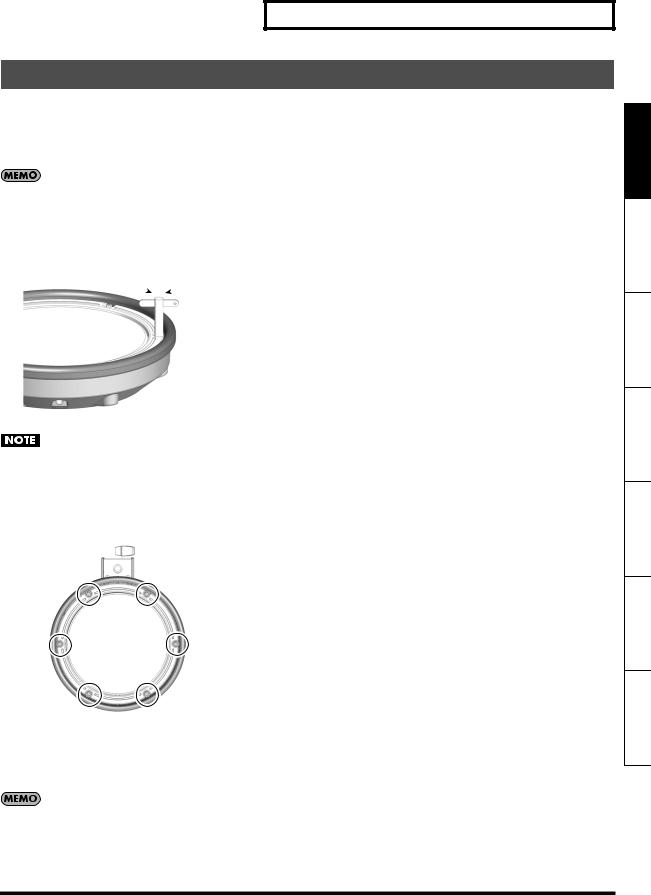
Getting Ready to Play
Tensioning the Head of a Mesh Pad (PDX-8)
BEFORE using the PDX-8 mesh pads you must adjust the tension.
You can tension mesh heads the same way you do with acoustic drums.
*Use a drum key to make adjustments.
Adjusting the tension of the PDX-8 head is only for playing response and will not affect the pitch as on an acoustic drum.
1.Use the included drum key to tighten the tuning bolts.
Strike the head to check the feel and response.
Loosen  Tighten
Tighten
Tighten the tuning bolts in the numerical order shown in the following illustration. If you firmly tighten a tuning bolt at one location all at once, it will be impossible to stretch the head evenly, and this may cause triggering response problems.
61
4 |
3 |
25
2.Tension the head evenly as you test the playing feel, just as you would with an acoustic drum.
Head tension may slacken with the passage of time. Readjust the tension as needed.
English
Deutsch
Français
Italiano
Nederlands Português Español
11
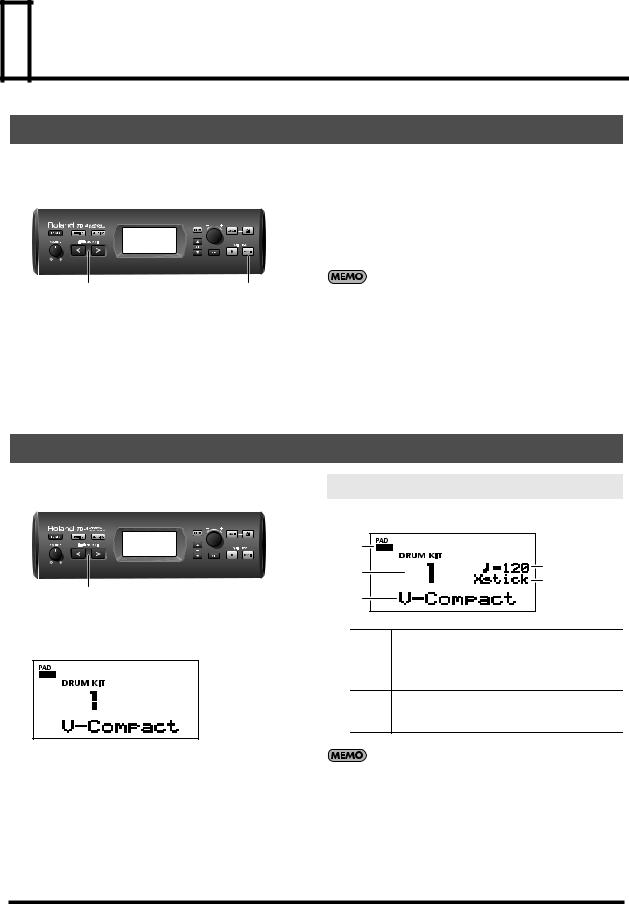
 Playing
Playing
Hearing What the Kits Sound Like
After turning the power on, you can play the demo patterns. Here’s how you can listen to the sounds by switching drum kits while playing the demo patterns.
2 |
1,3 |
*All rights reserved. Unauthorized use of this material for purposes other than private, personal enjoyment is a violation of applicable laws.
*No data for the demo patterns that is played will be output from MIDI OUT.
1.Press the [ 
 ] (Play/Stop) button. The demo patterns will play.
] (Play/Stop) button. The demo patterns will play.
2.Press the DRUM KIT [<] [>] buttons to select drum kit.
3.To stop demo pattern playback, press the [ 
 ] button once again.
] button once again.
When you press the [  ] (Rec) button to start recording your performance (p. 17), the demo patterns will temporarily
] (Rec) button to start recording your performance (p. 17), the demo patterns will temporarily
be erased. The next time you turn on the power, you will again be able to play the demo patterns.
Selecting a Drum Kit
A drum kit is a combination of the sounds & settings for each pad and pedal, as well as ambience.
1
1.Press the DRUM KIT [<] [>] buttons to select drum kit.
About the “DRUM KIT” screen
This is the TD-4’s basic screen.
D |
|
|
A |
C |
|
E |
||
|
||
B |
|
A |
Drum kit number |
B |
Drum kit name |
C |
This shows the metronome tempo (p. 17). |
|
|
D |
Strength of the pad strike displayed in 6 levels. |
This is shown if the cross-stick technique can be
Eused with the snare (p. 29).
(When Xstick Volume is anything other than OFF)
Regardless of the screen that is displayed, pressing the DRUM KIT [<] [>] buttons will access the “DRUM KIT” screen (except during recording/playback).
12
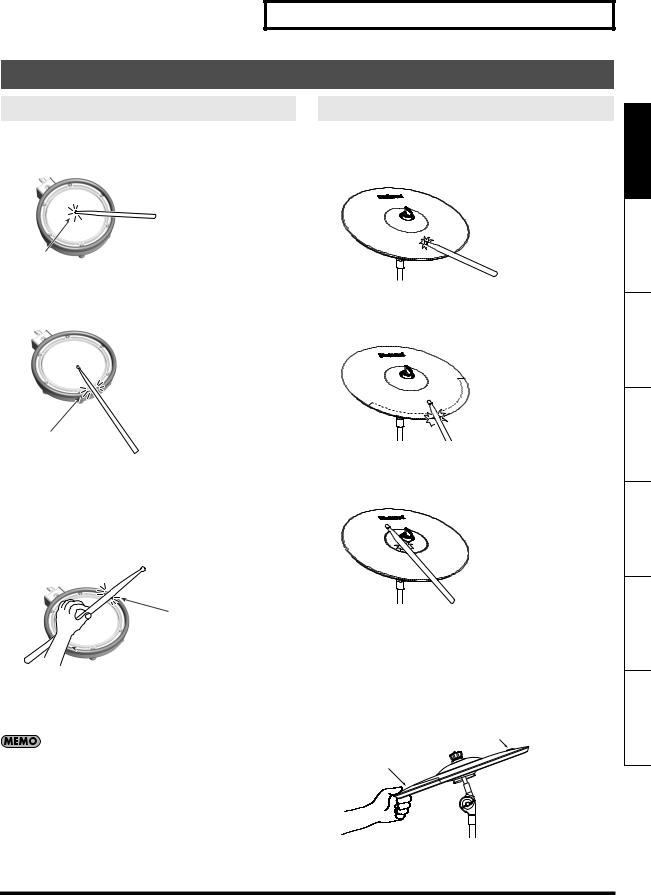
Playing
Performance Techniques
Pads (e.g., PDX-8, PD-8)
Head Shot
Hit only the head of the pad.
Head
Open Rim Shot
Strike the rim of the pad.
Rim
Cross Stick
Only strike the rim of the pad.
Velocity switching “snare rim” sound, played softly produces a cross stick sound, and when played harder, produces a open rim shot sound (p. 29).
Rim
 Rim
Rim
*To play the cross stick, be sure that you only strike the rim of the pad. Place your hand on the head gently, otherwise this may prevent the cross stick function from working properly.
When playing cross stick, set “Xstick Volume” (p. 29) to anything other than “OFF.”
Cymbals (e.g., CY-8, CY-12R/C)
Bow Shot
The most common method, playing the middle area of the cymbal.
Edge Shot
When striking the edge with the shoulder of the stick (as shown in the figure).
 Edge Sensor
Edge Sensor
Bell Shot (CY-12R/C, CY-15R)
This playing method involves striking the bell of the cymbal.
* Set the Crash 2 Usage setting (p. 36) to “RIDE BELL.”
* Strike the bell somewhat strongly with the shoulder of the stick.
Choking a Cymbal
Choking (pinching) the cymbal’s edge with the hand immediately after hitting the cymbal will mute or choke the sound, just like with a real cymbal. The Choke function only works when you grasp in the area (where the edge sensor is) as shown in the figure. If you do otherwise, it will not work.
Roland Logo
Edge Sensor
English
Deutsch
Français
Italiano
Nederlands Português Español
13
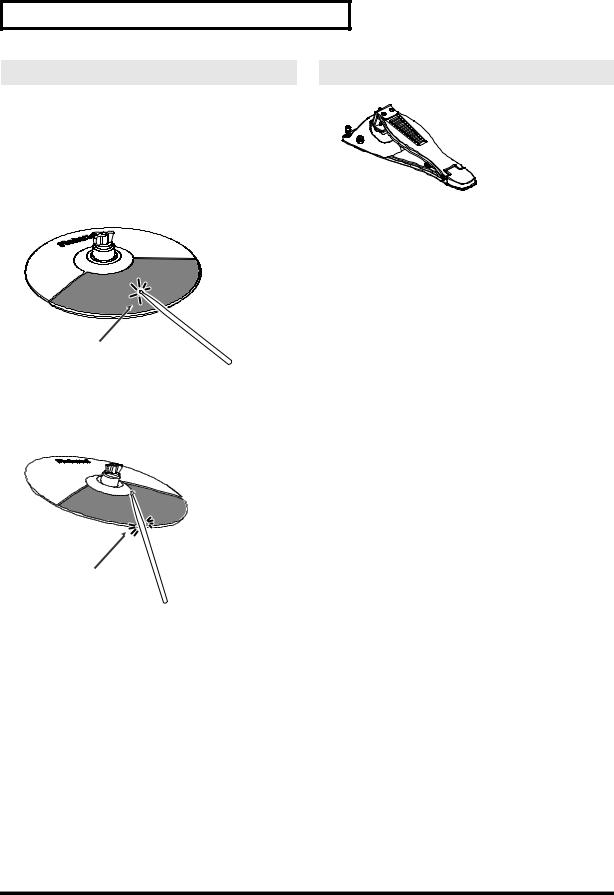
Playing
Hi-Hat (CY-5)
Open/Closed
The hi-hat sound will change smoothly between open and closed depending on pressure applied to the hi-hat control pedal.
Foot closed and foot splash sounds are possible.
Bow Shot
Playing the middle area of the hi-hat pad.
Bow
Edge Shot
Playing the edge of the hi-hat pad with the shoulder of the stick (as shown in the figure).
Hi-Hat Control Pedal FD-8
Open Hi-Hat
Strike the hi-hat without pressing the pedal.
Half Open Hi-Hat
Strike the hi-hat with the pedal pressed half-way.
Closed Hi-Hat
Strike the hi-hat with the pedal pressed.
Foot Closed
Completely press down the pedal.
Foot Splash
Quickly hitting the hi-hat pedal (with heel or toes) and instantly releasing it.
* Connect the FD-8 to the TD-4 before turning on the power.
Edge
14
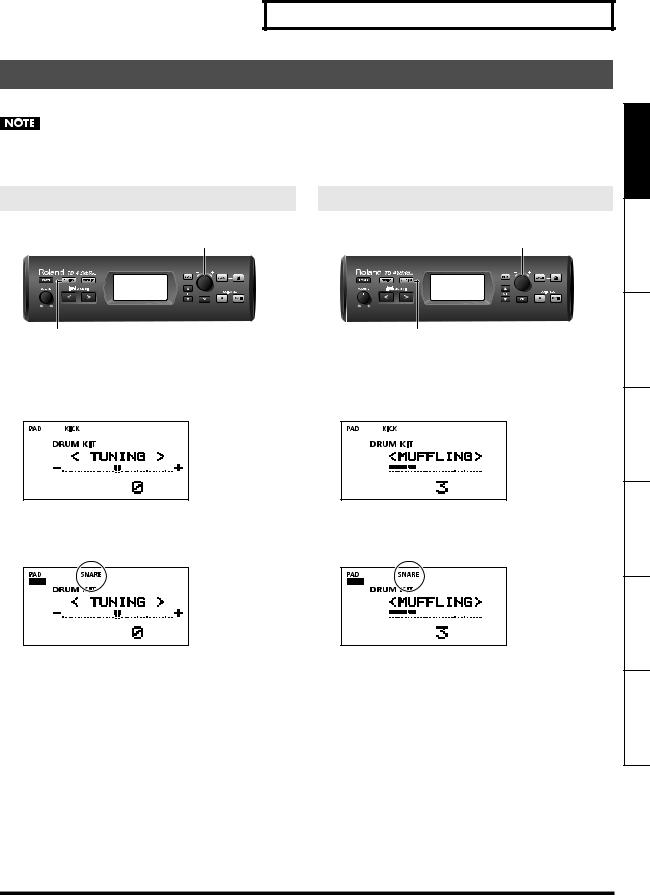
Playing
Quickly Tuning or Muffling
You can use dedicated buttons to quickly tune or muffle the sound. When you press the button, the sound you selected will be heard.
You cannot make tuning or muffling settings for pads to which an instrument (p. 28) in the cymbal-type instrument group (HIHAT, CRASH, RIDE) is assigned. For such pads, the display will indicate “- - -.”
TUNING
3
1, 5
1.Press the [TUNING] button so it’s lit.
The TUNING screen appears.
The selected pad will sound at this time.
2.Strike the pad that you want to tune.
The pad you struck will blink in the screen.
3.While striking the pad to hear the sound, turn the [- /+] dial to adjust the tuning.
Value: -600–0–+600
A negative (-) value will lower the pitch, and a positive (+) value will raise the pitch.
MUFFLING
3
1, 5
1.Press the [MUFFLING] button so it’s lit.
The MUFFLING screen appears.
The selected pad will sound at this time.
2.Strike the pad that you want to muffle.
The pad you struck will blink in the screen.
3.While striking the pad to hear the sound, turn the [-/+] dial to adjust the muffling.
Value: 0–10
Raising this value reduces the resonance and decay (length) of the sound.
4. |
Repeat steps 2–3 to adjust the tuning of each pad. |
4. |
Repeat steps 2–3 to adjust the muffling of each |
5. |
When you’ve finished tuning, press the [TUNING] |
|
pad. |
|
|
||
|
button to turn it off. |
5. |
When you’ve finished adjusting the muffling, press |
|
|
|
the [MUFFLING] button to turn it off. |
English
Deutsch
Français
Italiano
Nederlands Português Español
15
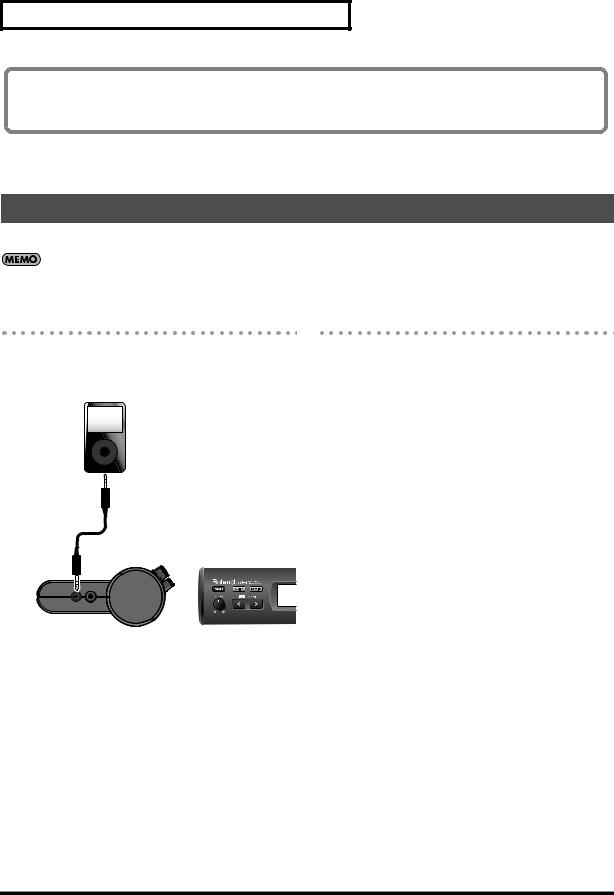
Playing
If Head/Rim Link (p. 37) is “ON,” both the HEAD and the RIM settings will be edited simultaneously.
In some cases, you may see an “*” in the right side of the screen; this indicates that the tuning/muffling values specified for the HEAD and the RIM are different.
Playing Along with a Portable Audio Player
By connecting a portable audio/CD player to the MIX IN jack you can play the TD-4 with your favorite songs.
You can connect other audio devices as well.
Connections
Lower the volume of the TD-4 and your audio player before making connections.
Portable Audio Player
Stereo miniature plug
*If a connection cable has built-in resistors, the volume level of the source connected to the TD-4 (MIX IN) may be too low. If this occurs, use connection cables that do not contain resistors.
Playback
1.Start the music on your portable audio player.
For details on how to use your audio player, refer to its owner’s manual.
2.Then adjust the volume of your portable audio player.
Sounds received at the MIX IN jack are output from the OUTPUT and PHONES jacks.
* Adjust the volume on the audio player to get the right balance between it and the TD-4.
3.Adjust the volume of the TD-4.
16
